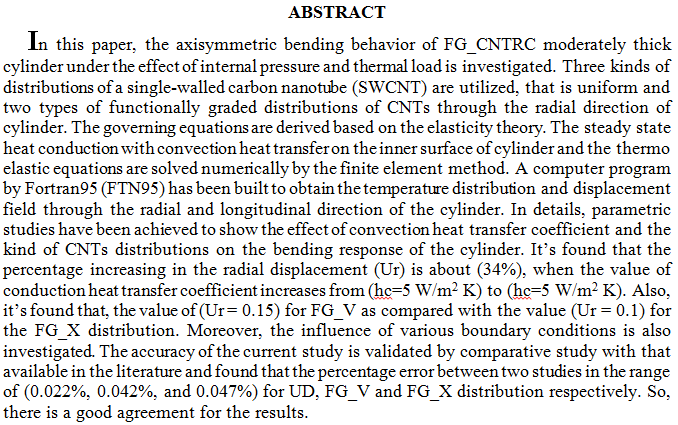

Phenol is one of the worst-damaging organic pollutants, and it produces a variety of very poisonous organic intermediates, thus it is important to find efficient ways to eliminate it. One of the promising techniques is sonoelectrochemical processing. However, the type of electrodes, removal efficiency, and process cost are the biggest challenges. The main goal of the present study is to investigate the removal of phenol by a sonoelectrochemical process with different anodes, such as graphite, stainless steel, and titanium. The best anode performance was optimized by using the Taguchi approach with an L16 orthogonal array. the degradation of phenol sonoelectrochemically was investigated with three process parameters: current de
... Show More (1)
(1)
 (1)
(1)
Electronic remote identification (ER-ID) is a new radio frequency (RF) technology that is initiated by the Federal Aviation Authorities (FAA). For security reasons, traffic control, and so on, ER-ID has been applied for drones by the FAA to enable them to transmit their unique identification and location so that unauthorized drones can be identified. The current limitation of the existing ER-ID algorithms is that the application is limited to the Wi-Fi and Bluetooth wireless controllers, which results in a maximum range of 10–20 m for Bluetooth and 50–100 m for Wi-Fi. In this study, a mathematical computing technique based on finite state automaton (FSA) is introduced to expand the range of the ER-ID RF system and reduce the ene
... Show More (5)
(5)
 (6)
(6)
Throughout this paper, a generic iteration algorithm for a finite family of total asymptotically quasi-nonexpansive maps in uniformly convex Banach space is suggested. As well as weak / strong convergence theorems of this algorithm to a common fixed point are established. Finally, illustrative numerical example by using Matlab is presented.
 (14)
(14)
 (3)
(3)
In this work we experimentally investigated SWCNTs and MWCNTs to increase their thermal conductivity and electrically functionalization process using different reagents ((nitric acid, HNO3 followed by acid treatment with H2SO4), then washed with deionized water (DW) and then treated with H2O2 via ultrasonic technique. Then repeated the steps with MWCNTs and compare their results in an effort to improve experimental conditions that efficiently differentiate the surface of the single walled carbon nanotubes (SWCNTs) and multi walled carbon nanotubesi(MWCNTs) that less nanotubes destroy and to enhance the properties of them and also to reduce aggregation in liquid. the results were prove by XRD, and infrared spectroscopy (FTIR). The FTIR sp
... Show More (3)
(3)
The aim of this study is to investigate the behavior of composite castellated beam in which the concrete slab and steel beam connected together with headed studs shear connectors. Four simply supported composite beams with various degree of castellation were tested under two point static loads. One of these beams was built up using standard steel beam, i.e. without web openings, to be a reference beam. The other three beams were fabricated from the same steel I-section with various three castellation ratios, (25, 35, and 45) %. In all beams the concrete slab has the same section and properties. Deflection at mid span of all beams was measured at each 10 kN load increment. The test results show that the castellation process leads to
... Show MoreHeavy metal ion removal from industrial wastewater treatment systems is still difficult because it contains organic contaminants. In this study, functional composite hydrogels with photo Fenton reaction activity were used to decompose organic contaminants. Fe3O4 Nanoparticle, chitosan (CS), and other materials make up the hydrogel. There are different factors that affected Photo-Fenton activity including (pH, H2O2 conc., temp., and exposure period). Atomic force microscopy was used to examine the morphology of the composite and its average diameter (AFM). After 60 minutes of exposure to UV radiation, CS/ Fe3O4 hydrogel composite had degraded methylene blue (M.B.)
... Show More (4)
(4)
In this study, Laser Shock Peening (LSP) effect on the polymeric composite materials has been investigated experimentally. Polymeric composite materials are widely used because they are easy to fabricate and have many attractive features. Unsaturated polyester resin as a matrix was selected and Aluminum powder with micro particles as a reinforcement material was used with different volume fraction (2.5%, 5% and 7.5%). Hand lay-up process was used for preparation the composites. Fatigue test with constant amplitude with stress ratio (R =-1) was carried out before and after LSP process with two levels of energy (1Joule and 2Joule). The result showed an increase in the endurance strength of 25.448% at 7.5% volume fraction when peened is 1J
... Show More